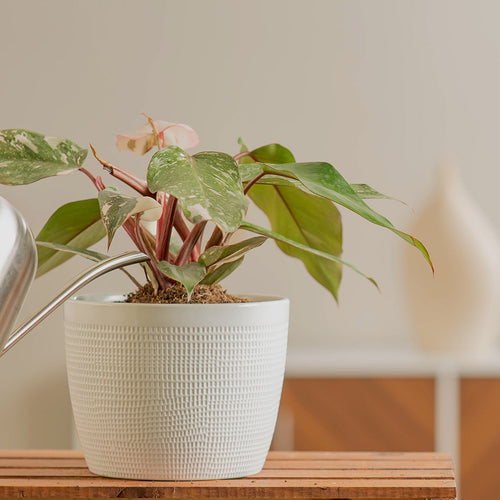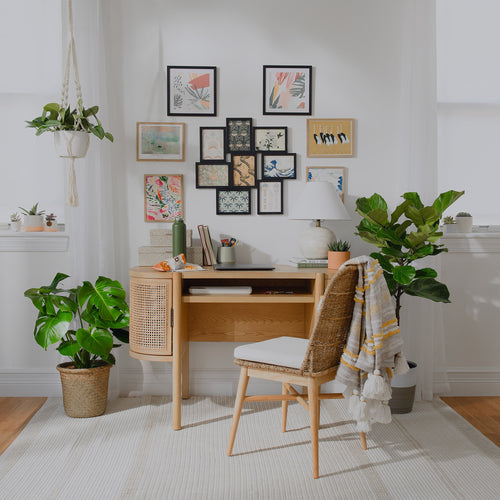 By Karen Weir-Jimerson
By Karen Weir-JimersonPeperomia: it sounds more like an Italian meat or pasta than a plant group. But peperomia is a large group (of more than 1000 different types) of extremely interesting and diverse houseplants. Not all of these plants are in cultivation and sold, of course. But there are a pack of peperomias that are in production and once you’ve raised one, and see how beautiful and easy they are, you might just need another. Then another.
What do Peperomias look like?
This plant group has such a wide range of looks that it can be hard to quickly identify them, like you would a snake plant or a philodendron. But their diversity means that they can be your go-to plant for many needs. Small species can fit in terrariums. Hanging/draping peperomias, such as Peperomia prostata, can fill vertical spaces. There are peperomias with smooth, waxy leaves, such as 'Jelly.' Others sport leaves that are crinkly and ribbed, such as 'Red Ripple.'
There are types with green leaves, variegated leaves, and red leaves with silver metallic stripes (Columbian peperomia). Some have heart-shape leaves with red stems (Peperomia perciliata). And while peperomia have several not-very descriptive common names (radiator plant, baby rubber plant), maybe this plant should be known as The Surprising Plant, because it offers so much diversity within one species.
Peperomias are in the pepper family (Piperaceae). They are not related to the bell and hot pepper family, but are members of the black pepper clan (like salt and pepper). No part of the peperomia is edible. Although plants range greatly in look, most plants are generally small, growing no more than 12 inches tall and have thick stems and fleshy leaves. Peperomia are exclusively known for their foliage; their flowers are interesting, but insignificant spikes. Most peperomia are found growing in tropical and subtropical areas of Central America, South America, and Africa.
 Stand-alone beauty or mixable charm
Stand-alone beauty or mixable charmIf you are looking for a singular plant that holds its own in a container, a member of the peperomia family will most likely fit the bill. The textural and colorful leaves of this plant allows you to get a lot of looks with just one plant species. If you have a smooth black pot, go with a showy little number, such as Peperomia metallica var. columbiana with bronze-purple leaves striped with metallic-silver, to create a bold contrast.
Or if you have a demonstrative container with a lot of texture or color, use a more subdued peperomia, such as 'Belly Button' (Peperomia verticillata). And if you want to mix plants, like you do in a terrarium, peperomia, such as Peperomia japonica, are good choices because they offer color and texture, raising the profile of the plants around them. In other words, a peperomia can be the lead singer in the band of harmonizers.
Shopping for peperomia
Look for plants with healthy firm leaves and stems. If plants have yellow leaves, they may have been overwatered. To see a selection of peperomias, shop these locations.
Although these plants all look different, they have several common attributes. Peperomias are easy to grow -- one of the easiest. And they are slow growing -- they won’t take off on you. Here are some other elements of caring for peperomia that you need to know:
Light
Regardless of their leaf shape, texture, or color, peperomia do best in bright indirect light. This means they like light from west- or east-facing windows. They definitely don’t like to sit in bright glaring light which can burn their leaves. You can also grow peperomia under fluorescent lights. If they don’t get enough light, these slow-growing plants will grow even slower.
 Water
Water Peperomias, such as small-leafed 'Bibi,' don’t like to be overwatered. (Most houseplants don't!) Too much hydration can cause their roots to rot in wet soil. The best way to determine when to water a peperomia is to wiggle your finger into the soil down about an inch. If it is dry, it’s time to water. Don’t pour water on the leaves; always water the soil at the base of the plant. If peperomias are overwatered, their leaves will yellow. Keep in mind that Peperomia, although not succulents, have succulent-like leaves that hold water. Their unthirsty nature is one of the reasons they are so easy to care for. If you want to simplify watering, use a Wick and Grow ™ system, which waters from the bottom of the plant, allowing the plant to wick up water as it needs it.
Temperature
Peperomia, like all tropical plants, like life on the water side, preferring a range of temperatures between 60 and 80 degrees F. You can keep your peperomia on a porch or patio until the temperatures cool to 50 to 55 degrees F., then you should bring them back indoors. Keep plants away from cool drafts from doors and windows or hot blasts from heating vents or fireplaces.
Fertilizer
To keep plants healthy, feed with houseplant food in the spring and summer. Follow application directions. Don’t over feed.
To discover more about the charms of all peperomia, see all our varieties.

















